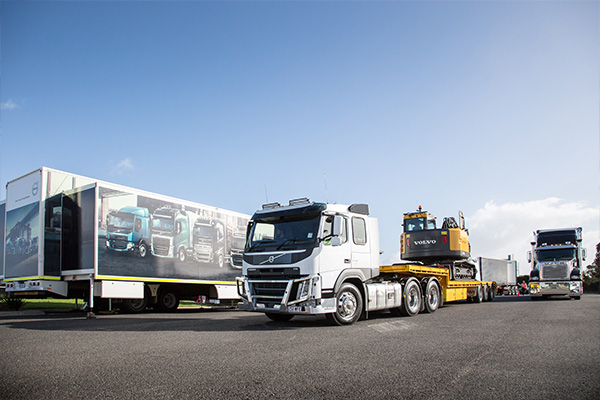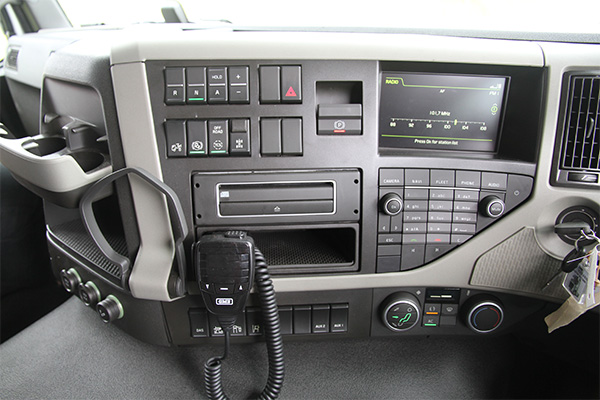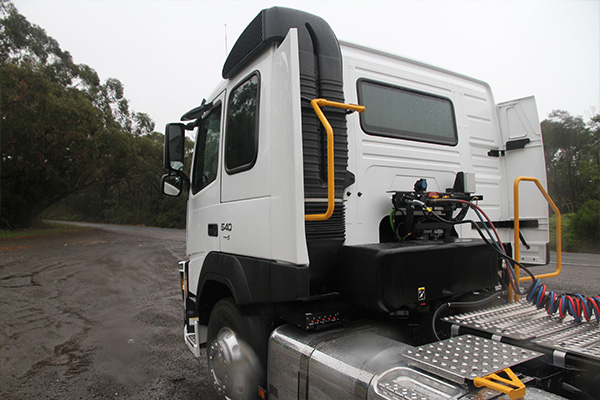It’s time to get reacquainted with an undisputed favourite, the Volvo FM
There’s no question Volvo’s new FH flagship has been a raging success almost from the day it first appeared on dealer’s lots. Sales figures prove it.
Still, it’s the incredibly versatile FM which has continued to provide the platform for the Swedish brand’s strong performance over many years.
I won’t beat around the bush. Now more than ever, the Volvo FM stands out as one of my all-time favourite trucks.
Not because it belts out blistering performance or provides a lavish ‘office’ with all the bells and whistles, or is entirely fault-free. And certainly not for its ability to make other drivers envious or deliver an ego trip every time you step into the cab.
In fact, if it came to choosing a big banger to run the length and breadth of the country, I would shamelessly prefer something with more cubes, more bunk and a snout out the front.
So, what is it that makes the ubiquitous FM such a stand-out attraction?
Well, in my estimation – and obviously the estimations of many others – it’s just so right for so many jobs and these days particularly, it does those jobs with degrees of finesse, comfort, reliability and efficiency which set an exceptionally high standard.
Think about it! Here’s a truck that can be found just about everywhere doing just about everything, from pulling a single trailer around cities and suburbs, working as an eight-wheeler with or without a dog trailer attached, or hauling a B-double on shorthaul or even linehaul runs. And when needs dictate, it definitely wouldn’t be surprising to find a few in the backblocks occasionally attached to a set of roadtrain doubles.
Yet these are just the tip of the iceberg.
In fact, perhaps the biggest examples of FM versatility and modern-day acceptance are to be found in those PBS (Performance-Based Standards) roles where the stoic Swede works as a rigid tipper pulling a five or even six-axle dog trailer.
What’s more, it’s no exaggeration to suggest the FM did more to blaze the trail for these unique combinations than any other make or model.
That’s not to say, of course, other brands aren’t entirely capable of providing the same standards of application versatility.
It’s just that judging by the sheer number of FMs found in such a broad diversity of applications, few do it with the same levels of market acceptance or operational aptitude.
It is truly a quiet achiever, in every sense.
Engine and Transmission
The top rating these days is the FM 540 model punched by Volvo’s six cylinder D13C engine with an SCR emissions system configured to Euro 5 standard.
Available in both the FM and its big brother FH, the D13C dispenses 540hp (397 kW) from 1,450 to 1,900 rpm and a tad over 1,900 lb/ft (2600 Nm) of torque from 1,050 to 1,450rpm.
Thus, you don’t have to be a genius to realise that from 1,050 rpm right through to 1,900 rpm, the 540 rating is delivering either maximum torque or maximum power, making it a convincingly gritty performer in most applications.
Yet for all its multi-faceted appeal, the FM is like any other truck in that it has definite limits. For instance, with a standard gross combination mass (GCM) rating of 70 tonnes, the FM 540 certainly has ample capacity for B-double duties but at weights of 60 tonnes-plus on time-sensitive linehaul runs, the 13-litre displacement – under either the FM or FH cab – struggles to match the deep-rooted tenacity of bigger bore engines.
Therefore, don’t be surprised if Volvo in the near future offers a 540hp version of its 16-litre engine under the taller FH cab.
Word has it that extensive fleet testing of several down-rated D16s (currently, the lowest 16-litre rating is 600hp) has not only shown an inherently greater ‘grunt’ factor over its 13-litre sibling but also significantly improved fuel consumption in top-weight linehaul B-double applications. No matter how you look at it, it’s one of those cases where bigger is definitely better.
Meantime, the current FM range will remain unchanged with the 540hp 13-litre engine continuing to head the horsepower list.
Cab and Controls
Volvo Group Australia’s recent ‘Heartland’ tour offered a number of different makes and models for test drives as the convoy traversed various parts of the country.
A couple of UDs, a pair of Macks and a trio of Volvos were all available and as several Volvo operatives confirmed, there were plenty of takers for the shiny big bangers from Mack and Volvo.
Fair enough, I suppose, but the opportunity to be reacquainted with the consistently successful and hugely versatile FM on a short run near home was simply too good to resist.
So, on a wickedly wet Saturday morning when an intense low pressure system decided to deluge much of eastern Australia, I made the short step up into the relatively low-slung FM cab after an absence of four years or more. And it is still such easy truck to like.
Sure, this particular unit was fitted with a swag of optional features but the fundamental qualities which have made the FM the truck of choice for a multitude of tasks start to emerge from the moment you pull the door shut. Like, there’s the immediate impression of good build quality, a comfortably practical work space and excellent all-round vision.
Equally noticeable, however, was the absence of a shift wand for the slick I-shift transmission.
Volvo had configured this transmission installation as a ‘Fleet Spec’, replacing the usual and occasionally over-used Cobra shift lever with a dash-mounted switch pad which sees the deletion of the ‘performance’ function to enhance simplicity and fuel efficiency but still allowing manual gear-hold and start gear default functions.
Meanwhile, another small bank of switches immediately underneath controls hill hold, traction control and diff lock functions, with another switch for cancelling the reversing alarm when working in suburban areas late at night. Smart move!
Yet whereas the switch pad was fitted to enhance simplicity, Volvo’s ‘smart’ steering wheel was at the other end of the spectrum, with a bevy of buttons on either side of the wheel hub controlling up to 25 individual functions for everything from phone use to cruise control to dash read-outs and … lots more! Of course, time and use bring familiarity but on first impression the complexity is confusing.
Still, as one Volvo operative was quick to point out, this particular unit was a demonstrator designed to highlight the FM’s ability to be specified for a diverse range of roles, from large fleets to owner-drivers.
In typical Volvo fashion, safety features were also high on the options list with the demo unit fitted with adaptive cruise control, lane change and lane keeping functions, a driver alert system and top of the tree, a forward collision warning function with emergency braking. There’s even an automatic headlamp switching function between high and low beam.
Another highly notable option was Volvo’s dynamic steering system, but we’ll get to that in a moment.
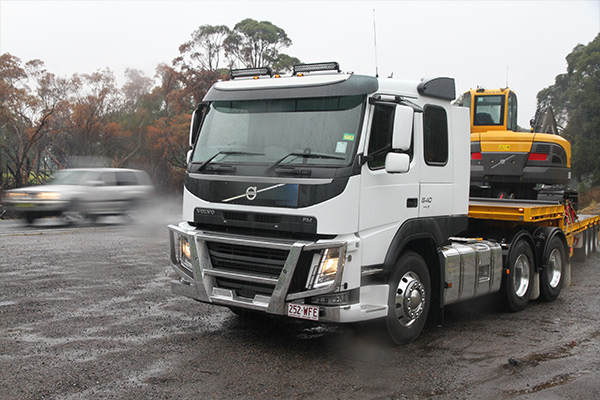
Performance
As for the powertrain and driveline spec, it’s an impressive outfit with the 540hp 13-litre engine feeding into a direct-drive version of Volvo’s stunningly smooth and incredibly intuitive I-shift transmission, putting power to the pavement through a Volvo drive tandem running a tall 3.09:1 rear axle ratio.
It’s a smart spec, combining good lift-off performance with the efficiency of cruising at 100 km/h with engine speed at a touch over 1,400rpm.
Critically, a standard braking system of electronically controlled disc brakes on all axles accompanied by an electronic stability program and three-stage Volvo Engine Brake made stopping performance typically strong and confident even in horribly wet and greasy conditions.
However, there was one feature found by chance that did not impress. Not one bit! For whatever reason, the park brake would release automatically when ‘D’ was selected and slight throttle pressure applied. For Volvo, a company which prides itself on the highest standards of safety, this was a surprising and somewhat questionable function.
Back on the positives, the truck was a sleeper cab version and typical of an FM specified for a multitude of regional prime mover roles.
Built on a 3,100 mm wheelbase with fuel capacity of over 1,000 litres in single tanks on each side and importantly, carried AdBlue capacity of 150 litres in the clever Aussie-designed tank mounted between the chassis rails.
As for the sleeper section, it’s certainly well short of ideal for long haul runs over several days but it’s at least ample for a few lazy hours or even overnight stops. You could do a lot worse.
Finally, I’ll end with Volvo’s dynamic steering (VDS) system. My first experience with this uniquely Volvo development was several years back in Sweden in the revamped FM range. I didn’t like it. Not at all. It was simply too sensitive to the slightest twitch of the wheel and several colleagues thought exactly the same.
Fortunately, Volvo engineers have done a lot of work in the meantime and the last few test drives in Australian Volvos fitted with VDS have revealed a vastly less sensitive system which now delivers an exceptionally direct and positive steering performance. For particularly rough roads or lots of off-road work, it is worth serious consideration.
Like so many other FM factors, VDS is another feather in the cap of a truck which just keeps evolving to the top of the class.
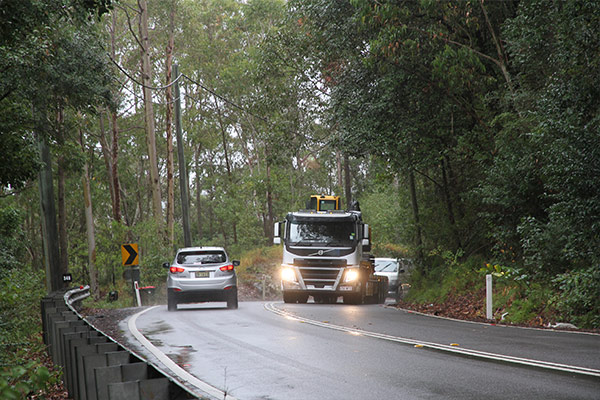
Verdict
There’s probably not much more to say other than comment on an on-road performance which was undeniably impressive.
Like I said, the day was an absolute shocker with unrelenting heavy rain and whilst a modestly sized excavator on a drop-deck tri-axle trailer certainly didn’t make the Swede sweat, the overall conclusion was nonetheless positive and indicative of why the Volvo FM is so popular with so many operators.
Specifications
Engine: Volvo D13C 13-litre Euro 5.
Performance: Power – 540hp (397 kW) @ 1,450 to 1,900 rpm. Torque – 2,600 Nm (1,917 lb/ft) @ 1,050 to 1,450 rpm.
Transmission: Volvo I-shift (AT2612D) direct-drive automated 12-speed.
Rear Axle: Volvo single reduction, 3.09:1 ratio.
Brakes: Volvo electronically-controlled disc brakes.
Fuel Capacity: 1,035 litres in 650 litre and 385 litre tanks. AdBlue 150 litres.
GCM: 70 tonnes (higher on application).



